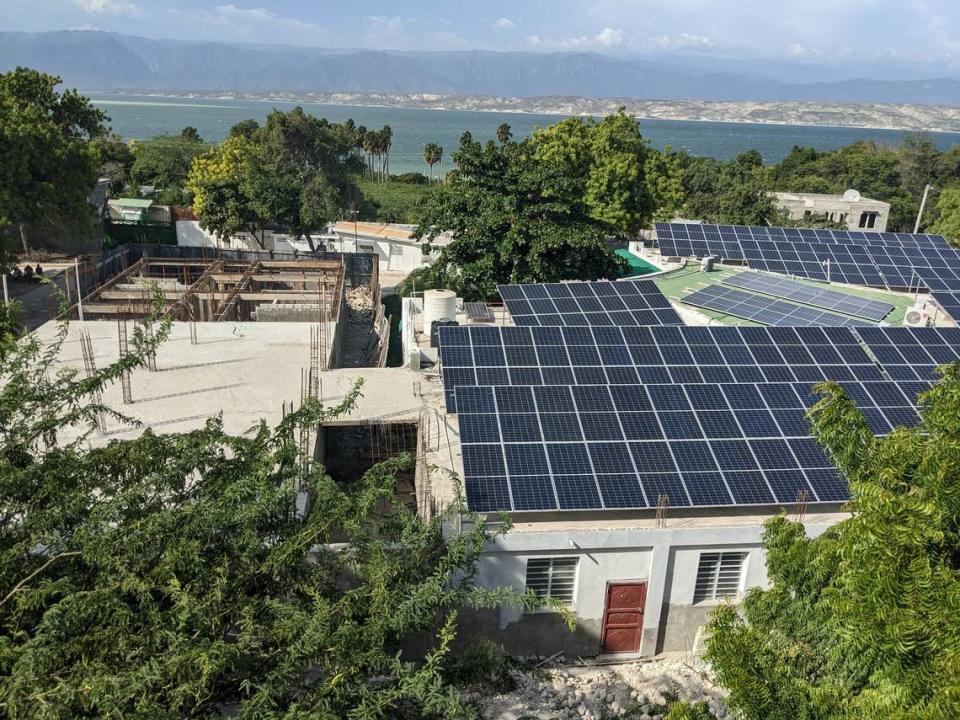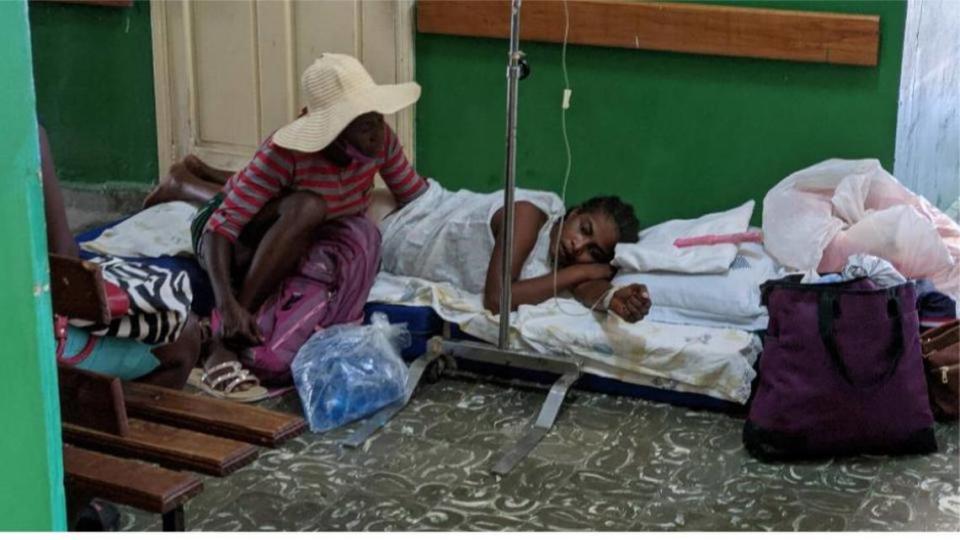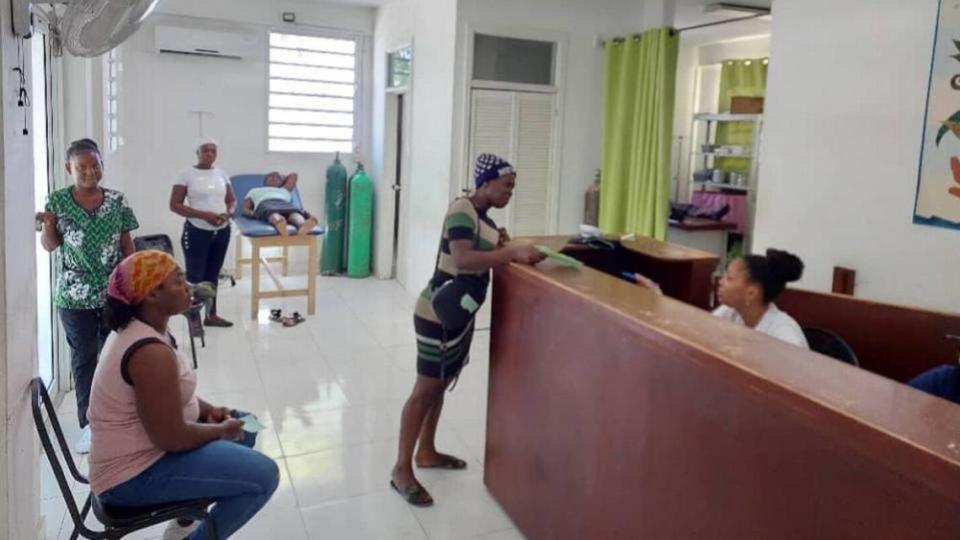Haiti-D.R. border shutdown forces hospitals, clinics to cut back on care, medications
The first casualty when the border between the Dominican Republic and Haiti was sealed shut over a river dispute was financial, paralyzing the normally brisk trade between the two nations.
Now it’s becoming a matter of life and death.
Trapped between armed gangs on one side and a closed border on the other, clinics and hospitals east of Haiti’s capital along the 220-mile border say they have been forced to turn patients away as they ration anesthesia and other medical supplies. They fear it’s just a matter of days before some facilities have no choice but to shut down altogether.
“We are performing only emergency operations to salvage what anesthesia medications we have left,” said Dr. Ted Higgins, a retired vascular surgeon based in Kansas City who built and operates a medical center in Fond-Parisien along National Road 8, which connects Port-au-Prince to the Dominican capital of Santo Domingo. “These are not easy decisions to make, and soon we will need to close down our operating rooms entirely simply from lack of obtainable medications for surgery. I am sure we are not alone.”
Higgins Brothers Surgicenter for Hope, named after Dr. Higgins’ father and uncle, both surgeons themselves, is located about seven miles from Malpasse, the Haitian border town across from Jimaní on the Dominican side. It has two full-sized operating rooms along with an emergency room open ‘round the clock and a trauma facility with 10 surgeons and anesthesiologists. The physicians, all Haitian, perform all types of surgeries, from orthopedic to urological to obstetrics and gynecology.
“Our clinic sees probably 1,300 patients a month,” said Higgins, who noted that about a quarter of the Haitian patients traditionally come from the Dominican Republic, and seven of the center’s staffers also live in Dominican towns. “We have a dentist who does restorative work, we have an HIV clinic that sees about 200 people a month, a maternity clinic, general medical clinic, pediatric.”

Because heavily armed groups control the road to his facility from Port-au-Prince, Higgins has been relying on the Dominican Republic for the past three years to get into Haiti. He flies from the U.S. into Santo Domingo, the Dominican capital, then hops in a car for the four-hour long drive to Jimaní and over the border into Malpasse. He’s had to halt his medical mission teams, which used to travel to Haiti so that U.S. specialists could train local Haitian doctors. He also suspended a teaching program with the State University of Haiti Hospital in Port-au-Prince.
When a tanker truck coming to deliver fuel was commandeered by gangs for ransom — and his chief surgeon, in a separate incident, took a bullet from armed gunmen — Higgins took drastic action. He switched the hospital to solar power and told staffers he didn’t want anybody traveling on the gang-infested roads to Port-au-Prince, so he began building them local housing.
“We’ve suffered. We’ve had a container that was hijacked, we’ve had people who have been kidnapped… So, we just go over to the Dominican Republic and work with them,” Higgins said, adding that the center turned to buying fuel, food, medicines and construction supplies in the Dominican Republic. “It’s been a lifeline.”
Higgins said he’s come to accept that ending the gang problem is going to take time. But now it’s been two weeks since Dominican President Luis Abinader suspended visas for Haitians and ordered a hard stop to all air, sea and land traffic with Haiti. The shutdown was in response to the construction of a canal by Haitian farmers near their northeastern border to divert water from the Massacre River, which straddles the two nations, to alleviate drought in Haiti’s Maribaroux plain.
“To shut down a border over irrigating a canal on the Massacre River? I mean, that doesn’t make sense,” Higgins said. “I know it’s a political situation and the [Dominican] president is running and he wants to get tough on Haiti. But that’s not the way you do it. You don’t pick on the weakest kid on the playground and beat him up, and then say, ‘Hey, see what I can do.’ “
The financial losses from the shutdown are spreading as well. The countries’ free zones of Caracol and CODEVI, and the industrial park in Port-au-Prince, are suffering as factories near the towns of Ouanaminthe and Dajabón, on either side of the river, find themselves unable to get raw materials and forced to suspend operations, affecting the livelihoods of some 200,000 workers on both sides of the border.
For several days now, dozens of U.S.-bound cargo containers with Hanes T-shirts and other products for major U.S. and Canadian brands have been paralyzed. Trucks with the products from over a dozen factories located on the border have been unable to cross into the Dominican Republic, where they traditionally ship from, and they’ve been unable to head to a Haitian port over fears by local authorities that the highly emotional population will be upset and retaliate thinking they are Dominican exports. On the Dominican side, more than a million eggs rot every day, because they can’t be sold across the border in Haitian markets.
“Haitians get a lot of their eggs from the Dominican Republic,” said Dr. David Vanderpool, founder of LiveBeyond, a medical disaster-relief organization that operates a 60-acre compound with a surgical hospital, demonstration farm, school and maternal health program not far from the Malpasse border near the community of Thomazeau. “This obviously is a basic food that’s going to be in short supply... and Haitians are already hungry.”

Before the shutdown, nearly half of Haiti’s population of 12 million was already going hungry, according to the World Food Program, which was forced in July to cut its food assistance to 100,000 Haitians due to lack of funding. Vanderpool, who runs a food program that provided meals to 8,000 children a day, said it has been forced to cut back by about 20% because of gangs blocking roads and preventing supplies from getting through from Port-au-Prince.
He believes the border closure will only worsen the humanitarian crisis in Haiti. Since the shutdown, Vanderpool said, his doctors, who were treating about 20,000 patients a month, are seeing “tremendous levels of hunger” and increasing malnutrition.
The U.N. and the U.S. have asked the Dominican Republic for a humanitarian exemption to allow emergency aid, food and medicine to pass through, and the Haitian embassy in France appealed to the European community, saying Haiti has a sovereign right to the water from the shared river under a 1929 international treaty.
On Tuesday, the Organization of American States said it has been holding talks with authorities from both nations over the canal’s construction.
“There can be no doubt that Haiti and the Dominican Republic have equal rights of use over the Dajabón or Massacre River and that its water resources are vital for both, given the needs of its inhabitants, especially in the current context of drought,” the OAS said. “This use must be ensured in accordance with international law and the treaties in force between both countries.”
The situation benefits neither country and the controversy should be resolved based on the principle of “good neighborliness and friendship between both countries and their leaders,” the OAS said.
But since the shutdown began the positions on both sides have hardened. Haitians, who see the Dominican stance as an affront to their sovereignty and a violation of the treaty, have rallied around the construction of the canal, donating money and construction material. Dominicans are divided. While the far right has applauded Abinader’s move, opposition politicians and businesses leaders dependent on the trade with Haiti have accused him of going too far.
And there’s a new development that threatens to escalate the crisis: The National Institute of Hydraulic Resources in the Dominican Republic has begun testing a pumping system in the La Vigía irrigation canal that would bypass Dajabón, the Dominican border town where the river runs. The pumps would counteract the effects of the canal being built on the Haitian side. The new system, critics say, was done without consultation with the Haitian government, which is supporting its farmers in the canal dispute.
“There is just this terrible animus between the Dominicans and Haitians, and closing the border over this irrigation canal, that just seems to me like an excuse,” said Vanderpool, whose nonprofit employs a staff of 125 in Thomazeau. “It is a huge problem.”

The border closure is also affecting cancer treatments. The University Hospital of Mirebalais, which recently came under a barrage of gunfire from gangs, sends between six to 10 patients a month to the Dominican Republic for oncology treatment, including radiation therapy that is not available in Haiti. The patients stay at guest houses in the Dominican Republic during their care and travel back and forth. There are currently eight patients who are stuck in the city of Santiago in the Dominican Republic, and with the border closed, the hospital says its bracing itself for a higher number of deaths due to the inability of Haitians to get care.
The Fort Myers-based nonprofit Love A Child, which runs a medical complex not far from the Malpasse-Jimaní border, is also feeling the squeeze between armed gangs, just 12 miles away, and the border shutdown.
“We can’t go up and we can’t go down,” said Dr. Assonic Barthélémy, the charity’s head physician, referring to its location between gang-ridden Port-au-Prince to the west and the shuttered border to the east.
Love A Child, founded by missionaries Bobby and Sherry Burnette, runs a free clinic, “Jesus Healing Center,” in the Fond-Parisien area and has a birthing center and malnutrition program. Patients do not pay for medical, consultations, labs or medicine.
The gang violence in the Croix-des-Bouquets area, where American missionaries were kidnapped in 2021, has made medical transfers to hospitals in Port-au-Prince out of the question. That left only Higgins’ surgical center and the town of Jimaní on the Dominican side, where patients were sometimes transferred by ambulance, for specialized care or testing.
“Now these patients can’t go because of the closed border,” Barthélémy said.
In the two weeks since the shutdown, he said, “we have had so many patients coming to see us that we really don’t have the ability to accommodate them.”
The border closure is also aggravating the other crises Haiti was already facing.
Earlier this month, the U.N.’s lead child welfare agency, UNICEF, said that nearly 3 million children in Haiti — the highest on record — are in need of humanitarian support due to alarming levels of violence, unprecedented hunger, malnutrition and a resurgence of deadly cholera.
Barthélémy, 36, said that while the escalation in violence is a factor in the increasing hunger rates, the border closure is making things worse. Haitian farmers who have been dealing with soil erosion, disastrous floods and the high cost of seeds and fertilizer have struggled to harvest crops, and had come to rely on the commerce of the border to make a living. Now that is gone, he said.
“We used to have two, three kids a week with malnutrition,” he added. “Now, there are so many children that are coming to us with malnutrition we don’t even have a place for them.”
Added to the worries, Barthélémy said, is that his facility is running low on supplies. A container full of medical supplies is stuck on the other side of the border in the Dominican Republic.
“This closure is really having an impact,” he said. “We are down to using our reserves.”

